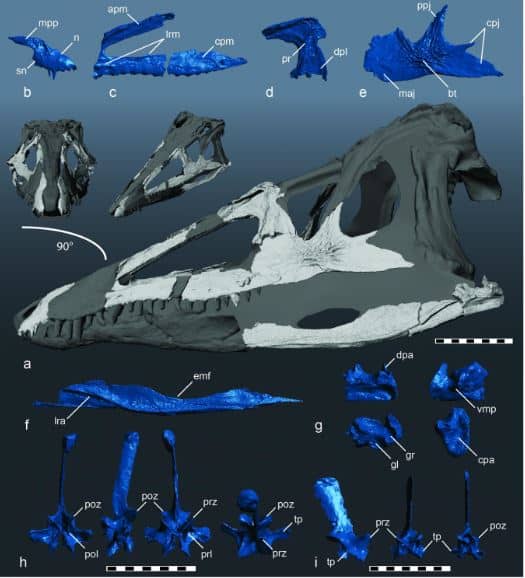A fearsome nine-foot long crocodilian ancestor was probably one of North America’s top predators about 231 million years ago, before the dinosaurs arrived, paleontologists from the North Carolina Museum of Natural Sciences and North Carolina State University reported this week.
Dubbed the ‘Carolina Butcher’ and known scientifically as Carnufex carolinensis, the land-dwelling crocodylomorph (modern crocodilian and its extinct relatives) walked upright, on its hind legs, and probably preyed on smaller wildlife of North Carolina ecosystems such as armored reptiles and early mammal relatives.
Their findings have been published in the open access journal Scientific Reports (citation below).

A life reconstruction of Carnufex carolinensis. (Image Credit: Jorge Gonzales)
Scientists recovered part of Carnufex’ upper forelimb, spine and skull from the Pekin Formation in Chatham County, North Carolina.
The creature’s skull was preserved in pieces, making it harder to visualize what the complete skull might have looked like when it was alive.
The researchers used a high-resolution surface scanner to get a fuller picture of Carnufex’ skull. They then created a 3-D model of the reconstructed skull, using the more complete skulls of closely related species to fill in the gaps.
The Pekin Formation is a geological formation in North Carolina which contains sediments deposited 231 million years ago, in the beginning of the Late Triassic (the Carnian). It was a wet, warm region with an equatorial climate that was starting to break apart from the supercontinent Pangea.

Image of a reconstructed skull of Carnufex carolinensis. 3-D surface models of skull bones are shown in white. Grey areas are the missing parts reconstructed from close relatives of Carnufex. (Image Credit: Lindsay Zanno)
Ancestors of crocodiles and birds
Lead author, Lindsay Zanno, assistant research professor at NC State, director of the Paleontology and Geology lab at the museum, said:
“Fossils from this time period are extremely important to scientists because they record the earliest appearance of crocodylomorphs and theropod dinosaurs, two groups that first evolved in the Triassic period, yet managed to survive to the present day in the form of crocodiles and birds.”
“The discovery of Carnufex, one of the world’s earliest and largest crocodylomorphs, adds new information to the push and pull of top terrestrial predators across Pangea.”
Other predators roaming Pangea included large-bodied poposauroids and rauisuchids, ancient crocodiles’ fearsome cousins that went extinct during the Triassic Period (between 251 million and 199 million years ago).
Prof. Zanno said “(In the Southern Hemisphere) these animals hunted alongside the earliest theropod dinosaurs, creating a predator pile-up.”
The theropod was a carnivorous dinosaur of a group whose members were typically two-legged (Tyrannosaurus rex was a theropod).
Discovery adds to diversity of predators at the time
However, this latest Carnufex discovery suggests that in the Northern Hemisphere, large-bodied crocodylomorphs, rather than dinosaurs, were adding to the diversity of creatures on top of the food chain.
Prof. Zanno added:
“We knew that there were too many top performers on the proverbial stage in the Late Triassic. Yet, until we deciphered the story behind Carnufex, it wasn’t clear that early crocodile ancestors were among those vying for top predator roles prior to the reign of dinosaurs in North America.”
Towards the end of the Triassic period, this panoply of predators became extinct and only small-bodied theropods and crocodylomorphs prevailed.
Prof. Zanno said:
“Theropods were ready understudies for vacant top predator niches when large-bodied crocs and their relatives bowed out. Predatory dinosaurs went on to fill these roles exclusively for the next 135 million years.”
Even so, ancient crocodiles thrived in other places. Co-author Susan Drymala, a graduate student at NC State, said:
“As theropod dinosaurs started to make it big, the ancestors of modern crocs initially took on a role similar to foxes or jackals, with small, sleek bodies and long limbs. If you want to picture these animals, just think of a modern day fox, but with alligator skin instead of fur.”
The specimen was recovered by Vincent Schneider, curator at N.C. Museum of Natural Sciences, and analyzed by Prof. Zanno and Ms. Drymala.
Citation: “Early crocodylomorph increases top tier predator diversity during rise of dinosaurs,” Lindsay E. Zanno, Susan Drymala, Sterling J. Nesbitt & Vincent P. Schneider. Scientific Reports. Published March 19, 2015. DOI: 10.1038/srep09276.
